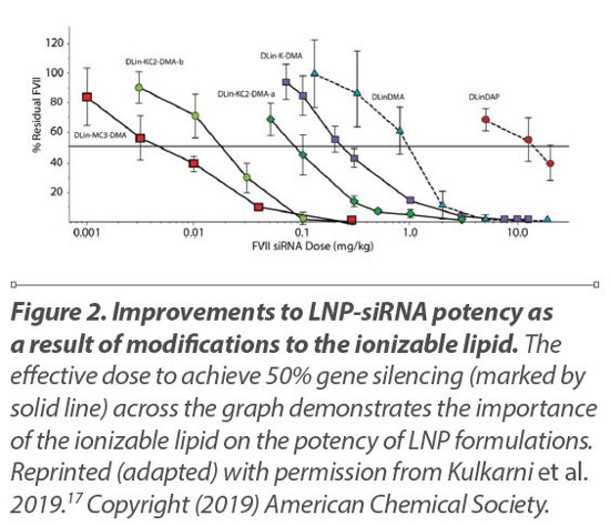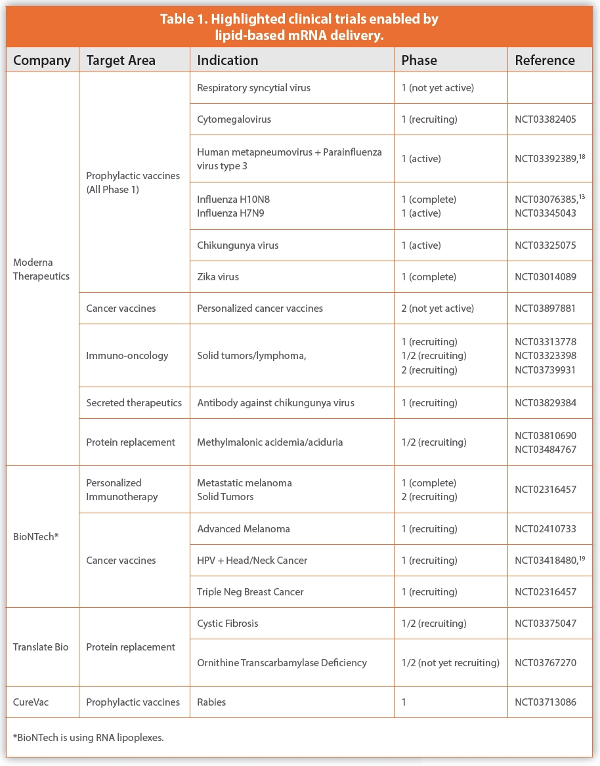Introduction
All cells function by an intricate mechanism that converts information stored as nucleic acid sequences (DNA) into messages (messenger RNA) for translation into functional products (protein). Endogenous checks and balances exist within this information flow, which can be leveraged as therapies to treat diseases closer to their genetic origin. The significant health opportunities of gene therapies are evident in the growing number of synthetic drugs, as well as modified viral delivery systems, which have recently been approved or entered clinical development.
Many of these products seek to decrease the presence of disease-causing proteins, counteract the effects of defective genes or introduce exogenous materials. Compared to conventional treatments designed to induce transient therapeutic effects, nucleic acid-based drugs can achieve more specific, long-lasting or curative effects. However, therapeutics based on unmodified nucleic acids display poor pharmacokinetics and biodistribution, are rapidly broken down in circulation, and can trigger immune responses. They also exhibit unfavorable physicochemical properties that prevent diffusion across the plasma membrane of target cells. Accordingly, the entry of nucleic-acid products into clinical development is largely dependent upon delivery technologies and applied chemistry that enable functionality.
In 2018, the FDA approved the first-ever RNA interference therapeutic product marketed as Onpattro®, a lipid nanoparticle (LNP)-based formulation of siRNA for the treatment of hereditary transthyretin (TTR) amyloidosis.1 This otherwise-fatal disease, characterized by the deposition of mutant TTR as amyloid fibrils in peripheral tissue, results in progressive degeneration. Its approval has validated LNP technology for the cytosolic delivery of most nucleic acid-based therapeutics. This article discusses the composition and manufacturing of LNP systems, as well as their current and future applications for mRNA delivery.
Composition: Role of individual lipids
LNPs typically consist of four components: ionizable cationic lipids, phospholipids, cholesterol, and polyethylene glycol (PEG)-lipids (Figure 1). Each component is responsible for payload protection, and enables effective intracellular delivery.2

Ionizable cationic lipids are fundamental drivers for nucleic acid entrapment, and determine the potency for intracellular delivery.2 These lipids contain a tertiary amine in their headgroup that responds to pH. Under acidic conditions, the amine is protonated or positively charged, while at neutral/basic pH the lipids are deprotonated, becoming uncharged. Such lipids have optimized acid-dissociation constants (pKa) to entrap nucleic acids at pH 4 during manufacturing yet display a near-neutral charge in circulation. Subsequently, they exhibit a strong positive charge in the acidic environment of endosomes following uptake into a cell. Additionally, these lipids have an inverted cone geometry that promotes the formation of the membrane-disruptive hexagonal (HII) lipid phase, promoting cytosolic translocation. The potency of LNP formulations of siRNA improved nearly 8000-fold by replacing the first generation ionizable lipid DLinDAP with MC3 (Figure 2).3
The exact role of phospholipids and cholesterol requires additional investigation. Formulations of small molecule therapeutics typically contain phospholipids and cholesterol at molar ratios of ~ 55-65/35-45.2 In such formulations, large amounts of cholesterol are included to prevent destabilization by lipid exchange in circulation, improve pharmacokinetic properties, and display favorable drug retention in complex biological media.4 For example, Onpattro® was designed based on the optimization of this ratio with ionizable cationic lipid, phospholipid, cholesterol and PEG-lipid at 50/10/38.5/1.5 mol, respectively.3
Subscribe to our e-Newsletters
Stay up to date with the latest news, articles, and events. Plus, get special offers
from American Pharmaceutical Review – all delivered right to your inbox! Sign up now!
PEG-lipids play a vital role in particle formation, stability and transfection competency. LNP-formulations use “diffusible” PEG-lipids containing C14 alkyl chains.5 During particle formation and storage, PEG-lipids help prevent particle aggregation by creating a steric barrier around the particle surface. Increases in PEG-lipid content correspond to smaller particle sizes to accommodate an increased amount of surface lipid.6 Shorter alkyl chains make these lipids exchangeable, and in the presence of a lipid sink, diffuse away from the LNP generating particles with an unshielded lipid surface. Adsorption of apolipoprotein E (ApoE) to the LNP is critically responsible for in vivo activity.7
Manufacturing Methods: Rapid-Mixing
Manufacturing of liposomes entrapping small molecule drugs for systemic administration at commercial scale are well-established, with extrusion being the most common process. However, for nucleic acid LNP manufacturing, substantially different processes can be required to overcome structural limitations and unfavorable physicochemical properties of the payload.8
Modern LNP production techniques draw from work by Batzri and Korn, where liposomes were produced by diluting an organic (ethanol)-phase of lipid into an aqueous buffer. Improvements to the technique of organic-aqueous phase mixing included the use of a T-junction mixer, where an ethanolic-lipid phase was combined with an acidic aqueous phase containing nucleic acid (to ensure protonation of the ionizable lipid) under turbulent flow conditions to promote rapid mixing. The resulting suspension was then buffer-exchanged into an isotonic buffer with neutral pH. In a single step, particle formation and efficient entrapment of nucleic acid (> 90%) could be achieved. More recently, microfluidic mixers were developed to produce particles with similar physicochemical properties.9 While the mixers/mixing efficiency can affect the intermediate stability and compositional heterogeneity of the LNPs, the final particle characteristics such as size, polydispersity, and morphology are largely a function of neutralizing the pH, and heterogeneity of the PEG-chains of the PEG-lipid.10,11

mRNA therapy: Protein Replacement, Vaccines, and Gene Editing
The significant potential of LNP-mRNA formulations in gene therapies is becoming more apparent each year. They can achieve high levels of gene expression without the requirement of nuclear translocation (compared to plasmids) and reduce the risk of genetic integration as with viral vectors whilst maintaining the ability to administer multiple doses through various routes. Such evidence underlines the strong trend towards the clinical development of such formulations by companies such as Moderna Translate Bio, BioNTech, and CureVac, (Table 1) alongside companies in earlier stages of development such as Intellia, CRISPR Tx, and Editas. Established proof-of-principle studies have demonstrated protein replacement, gene-editing, and vaccine applications of mRNA formulations.
LNP-based mRNA formulations display strong promise as therapeutics in disease states where genetic mutations result in a nonfunctional protein. For example, Translate Bio is currently running a Phase 1/2 study for delivery of cystic fibrosis transmembrane conductance regulator mRNA. Similarly, the concept of “liver as a bioreactor” has been suggested as a method of protein replacement targeting hepatocytes.2 In a clinical setting, Translate Bio and Moderna have active trials for treatment of metabolic liver diseases. Robust preclinical data also shows LNP-mRNA encoding erythropoietin (EPO) resulting in increased serum levels of EPO corresponding to increased reticulocyte count, and elevated hematocrit in porcine and non-human primate (NHP) models indicating clinical utility and potential.12

Vaccines also represent an ideal application for mRNA-therapeutics as relatively low amounts of mRNA are required, only limited doses are necessary, and multiple administration routes are available. A Phase 1 trial sponsored by Moderna for an influenza vaccine showed robust seroconversion of 78 - 88% subjects for H10N8 and 96 -100% subjects for H7N9 strains.13 Preclinical evidence by Pardi et al. showed that mice and primates were protected from a Zika-virus insult by an LNP-mRNA vaccine encoding the pre-membrane envelope protein of Zika.14 Another key preclinical example is the development of an mRNA vaccine against influenza virus hemagglutinin stalk, which is known to be challenging to raise an antibody response against. Simple modifi cation of the mRNA also allows for such vaccines to be used in cancer immunotherapies.14
Finally, applications for gene editing remain largely preclinical as the barrier to achieving robust editing (rather than simple knockout) has not been demonstrated in higher-order mammals. Numerous delivery formats have been explored for Cas9 and gRNA in a therapeutic context. Yin et al. used a combination of viral delivery (gRNA and repair template) with LNP-mRNA (Cas9) to correct mutations in fumarylacetoacetate hydrolase resulting in editing of ~6% hepatocytes.15 More recently, Acuitas and Sangamo showed LNP delivery of mRNA encoding zinc-fi nger nucleases (ZFN) targeting transthyretin and pcsk9 resulted in > 90% knockout at mRNA doses 10-fold lower than reported previously. In the same study, co-delivery of LNP-mRNA encoding ZFN targeting the albumin gene and viral delivery of templates for promotor-less human IDS or FIX generate therapeutically relevant levels of those proteins in murine models.16 This potency improvement likely results from ionizable cationic lipid design improvements, and represents the most advanced preclinical demonstration of gene editing (rather than knockout).

Outlook
LNP-mRNA technologies will continue to enable the development of gene therapies for use across multiple disease areas. A key LNP technology advantage is its amenability to various nucleic acid payloads and sizes without significant modification to the composition, and reduction in doses required to achieve a therapeutic effect. However, because LNP formulations are highly complex, collaboration with CDMOs with a strong record in LNP development and manufacturing can reduce development risk and streamline the path from initial feasibility to commercial launch. Further developments in mRNA production and modification, ionizable lipid function (potency), new targeting approaches and better understanding of LNP biophysics are likely to enable additional gene therapy applications. With preclinical and early phase clinical data showing strong potential, LNP-mRNAbased formulations represent a major breakthrough in nanomedicine.
References
- Alnylam press release: FDA Approval of ONPATTRO ™, 10 Aug 2018.
- Kulkarni JA, et al. 2018,10.1089/nat.2018.0721
- Jayaraman M, et al. 2012,10.1002/anie.201203263
- Rodrigueza WV, et al. 1993,10.1016/0005-2736(93)90270-a
- Ambegia E, et al. 2005,10.1016/j.bbamem.2005.02.001
- Chen S, et al. 2016,10.1016/j.jconrel.2016.05.059
- Akinc A, et al. 2010,10.1038/mt.2010.85
- Evers MJW, et al. 2018,doi:10.1002/smtd.201700375
- Precision NanoSystems Inc. (www.precisionnanosystems.com)
- Kulkarni JA, et al. 2018,10.1021/acsnano.8b01516
- Kulkarni JA, et al. 2019,10.1039/C9NR02004G
- Thess A, et al. 2015,10.1038/mt.2015.103
- Feldman RA, et al. 2019,10.1016/j.vaccine.2019.04.074
- Pardi N, et al. 2018,10.1038/nrd.2017.243
- Yin H, et al. 2016,10.1038/nbt.3471
- Conway A, et al. 2019,10.1016/j.ymthe.2019.03.003
- Kulkarni JA, et al. 2019, Accounts of Chemical Research, in press.
- Moderna Press Release: Phase 1 Data for First Combination Vaccine Against the Respiratory Viruses hMPV and PIV3, Feb 2019.
- Grunwitz C, et al. 2018,10.1136/esmoopen-2018-EACR25.531
Author Profiles
Dr. Maurer is the head of Research and Development at Evonik Vancouver Laboratories, a CDMO specialist for lipid nanoparticle-based drug delivery within the Health Care business line of Evonik Industries. Dr. Maurer has a track record of advancing drug technologies including liposomal formulations of anticancer agents from discovery through preclinical development into clinical trials over more than 20 years. He received his doctorate in Physical Chemistry from Karl-Franzens University in Austria in 1994. He is the author of more than 30 peer reviewed papers, review articles and book chapters and an inventor on 6 patents.
Dr. Kulkarni is a Scientist at Evonik Vancouver Laboratories specializing in the development of lipid nanoparticles. He received his doctorate in Biochemistry and Molecular Biology from the University of British Columbia in 2018. He has published several peer reviewed articles and reviews relating to lipid nanoparticles and gene delivery.